Properties of High-Flowability Liquefied Stabilized Soil Made of Recycled Construction Sludge
Abstract
:1. Introduction
2. Liquefied Stabilized Soils and High-Flowability Liquefied Stabilized Soils
2.1. Liquefied Stabilized Soils (LSSs)
- (1)
- Any construction-generated soil can be used;
- (2)
- Compaction work is not required;
- (3)
- The flowability and strength can be adjusted as needed;
- (4)
- It exhibits low permeability and high cohesive strength, rendering it impervious to groundwater erosion;
- (5)
- High adhesion prevents liquefaction during earthquakes;
- (6)
- It experiences low volumetric shrinkage and compaction after casting.
2.2. High-Flowability Liquefied Stabilized Soil Made of Recycled Construction Sludge (HFLSS Made of RCS)
3. Materials and Methods
3.1. Specimen Used in Mechanical Tests
3.2. Overview of Mechanical Tests
3.2.1. Flat-Plate Loading Test
3.2.2. Screw Weight Sounding Test
3.2.3. Unconfined Compression Test
3.2.4. Consolidation Test
3.2.5. Flow Test
4. Results of Mechanical Tests
4.1. Flat-Plate Loading Test
4.2. Screw Weight Sounding Test
4.3. Unconfined Compression Test
4.4. Consolidation Test
4.5. Flow Test
5. Discussion for Mechanical Tests
- (1)
- The self-weight or load should not cause fracture or compressive settlement of the LSS (unconfined compressive strength should be higher than the deviator stress that occurs when soil overburden pressure is applied to the LSS);
- (2)
- The required strength of the roadbed must be satisfied;
- (3)
- Re-excavation should be possible (when re-excavation is assumed to be necessary due to backfilling of buried pipes, etc., care should be taken so that re-excavation will not be difficult due to excessively high strength);
- (4)
- Proper load transmission should be ensured.
6. Conclusions
- (1)
- The mechanical properties of HFLSS made of RCS were lower than those of conventional LSS;
- (2)
- The unconfined compressive strength required for ordinary backfilling is 100–300 kN/m2 or higher in most cases, and HFLSS made of RCS meets the required quality;
- (3)
- HFLSS made of RCS can be used not only for finishing but also as backfill or filling material, and it can be expected to provide high filling performance at lower pumping pressure;
- (4)
- The reason for the higher flowability of HFLSS made of RCS is its lower specific gravity;
- (5)
- HFLSS made of RCS is superior to conventional LSS in long-distance pumping and installation in complex spaces.
Author Contributions
Funding
Institutional Review Board Statement
Informed Consent Statement
Data Availability Statement
Conflicts of Interest
References
- Nilimaa, J. Smart materials and technologies for sustainable concrete construction. Dev. Built Environ. 2023, 15, 100177. [Google Scholar] [CrossRef]
- Grebenkov, D.S. Depletion of resources by a population of diffusing species. Phys. Rev. E 2022, 105, 054402. [Google Scholar] [CrossRef] [PubMed]
- Wada, Y.; van Beek, L.P.H.; van Kempen, C.M.; Reckman, J.W.T.M.; Vasak, S.; Bierkens, M.F.P. Global depletion of groundwater resources. Geophys. Res. Lett. 2010, 37, L20402. [Google Scholar] [CrossRef]
- Public Works Research Institute; LSS Method Engineering Consultants Inc. Manual for Utilization of Liquefied Stabilized Soil, 2nd ed.; Gihodo Shuppan Co., Ltd.: Tokyo, Japan, 2007. [Google Scholar]
- Inazumi, S.; Kaneko, M.; Tomoda, Y.; Shigematsu, Y.; Shishido, K. Evaluation of flow-ability on fluidization treated soils based on flow analysis by MPS method. Int. J. GEOMATE Geotech. Constr. Mater. Environ. 2017, 12, 53–58. [Google Scholar] [CrossRef]
- Inazumi, S.; Kaneko, M.; Shigematsu, Y.; Shishido, K. Fluidity evaluation of fluidisation treated soils based on the moving particle semi-implicit method. Int. J. Geotech. Eng. 2018, 12, 325–336. [Google Scholar] [CrossRef]
- Inazumi, S.; Shigematsu, Y.; Nakao, K.; Shishido, K. 3-D particle flow analysis for fluidization treated soils. Am. J. Civ. Environ. Eng. 2018, 3, 59–67. [Google Scholar]
- Le, H.K.; Kohata, Y. Strength and deformation properties of liquefied stabilized soil prepared by various conditions. Int. J. GEOMATE Geotech. Constr. Mater. Environ. 2020, 23, 179–188. [Google Scholar] [CrossRef]
- Cui, Y.; Kohata, Y.; Liu, W. Influence of cement solidification agent and slurry density on mechanical property of liquefied stabilized soil. Int. J. GEOMATE Geotech. Constr. Mater. Environ. 2020, 19, 177–184. [Google Scholar] [CrossRef]
- Ministry of Land, Infrastructure, Transport and Tourism. Results of the Construction Byproduct Sustainability Survey in 2018 (Signalized Values) Reference Materials; Ministry of Land, Infrastructure, Transport and Tourism: Tokyo, Japan, 2018; pp. 1–5. [Google Scholar]
- Sakai, S. Municipal solid waste management in Japan. Waste Manag. 1996, 16, 395–405. [Google Scholar] [CrossRef]
- Hird, M.J.; Lougheed, S.; Rowe, R.K.; Kuyvenhoven, C. Making waste management public (or falling back to sleep). Soc. Stud. Sci. 2014, 44, 441–465. [Google Scholar] [CrossRef]
- Komine, H.; Watanabe, Y. The past, present and future of the geo-environment in Japan. Soils Found. 2010, 50, 977–982. [Google Scholar] [CrossRef]
- Yoshida, H.; Shimamura, K.; Aizawa, H. 3R strategies for the establishment of an international sound material-cycle society. J. Mater. Cycles Waste Manag. 2007, 9, 101–111. [Google Scholar] [CrossRef]
- Nozaki, N.; Lu, K.; Singh, R.K.; Mizunoya, T.; Yabar, H.; Higano, Y. Simulation analysis of policy for waste treatment toward a sound material-cycle society in Tokyo. J. Sustain. Dev. 2017, 10, 65. [Google Scholar] [CrossRef]
- Johnson, O.A.; Napiah, M.; Kamaruddin, I. Potential uses of waste sludge in construction industry: A review. Res. J. Appl. Sci. Eng. Technol. 2014, 8, 565–570. [Google Scholar] [CrossRef]
- Raheem, A.; Sikarwar, V.S.; He, J.; Dastyar, W.; Dionysiou, D.D.; Wang, W.; Zhao, M. Opportunities and challenges in sustainable treatment and resource reuse of sewage sludge: A review. Chem. Eng. J. 2018, 337, 616–641. [Google Scholar] [CrossRef]
- Oladejo, J.; Shi, K.; Luo, X.; Yang, G.; Wu, T. A review of sludge-to-energy recovery methods. Energies 2018, 12, 60. [Google Scholar] [CrossRef]
- Hadi, P.; Xu, M.; Ning, C.; Lin, C.S.K.; McKay, G. A critical review on preparation, characterization and utilization of sludge-derived activated carbons for wastewater treatment. Chem. Eng. J. 2015, 260, 895–906. [Google Scholar] [CrossRef]
- Takei, Y. Current state and future prospects of countermeasures to soil contamination. Sci. Technol. Trends 2010, 4, 55–67. [Google Scholar]
- Kermani, M.; Ebadi, T. The effect of oil contamination on the geotechnical properties of fine-grained soils. Soil Sediment Contam. Int. J. 2012, 21, 655–671. [Google Scholar] [CrossRef]
- Villaescusa, E. Geotechnical Design for Sublevel Open Stoping, 1st ed.; Routledge: Abingdon-on-Thames, UK, 2014. [Google Scholar]
- Liu, J.; Tian, Y.; Orton, S.L.; Said, A.M. Resistance of flat-plate buildings against progressive collapse. I: Modeling of slab-column connections. J. Struct. Eng. 2015, 141, 04015053. [Google Scholar] [CrossRef]
- White, D.J.; Vennapusa, P.; Roesler, J.R.; Vavrik, W. Plate load testing on layered pavement foundation system to charac-terize mechanistic parameters. In Proceedings of the Geo-Congress 2019: Geotechnical Materials, Modeling, and Testing 2019, Philadelphia, PA, USA, 24–27 March 2019; pp. 214–226. [Google Scholar]
- The Japanese Geotechnical Society. Japanese Geotechnical Society Standards: Geotechnical and Geoenvironmental Investigation Methods (Volume 2); The Japanese Geotechnical Society: Tokyo, Japan, 2015. [Google Scholar]
- The Japanese Geotechnical Society. Japanese Geotechnical Society Standards: Geotechnical and Geoenvironmental Investigation Methods (Volume 1); The Japanese Geotechnical Society: Tokyo, Japan, 2015. [Google Scholar]
- The Japanese Geotechnical Society. Japanese Geotechnical Society Standards: Laboratory Testing Standards of Geomaterials (Volume 2); The Japanese Geotechnical Society: Tokyo, Japan, 2015. [Google Scholar]
- The Japanese Geotechnical Society. Japanese Geotechnical Society Standards: Laboratory Testing Standards of Geomaterials (Volume 1); The Japanese Geotechnical Society: Tokyo, Japan, 2015. [Google Scholar]
- Kang, G.; Cikmit, A.A.; Tsuchida, T.; Honda, H.; Kim, Y.S. Strength development and microstructural characteristics of soft dredged clay stabilized with basic oxygen furnace steel slag. Constr. Build. Mater. 2019, 203, 501–513. [Google Scholar] [CrossRef]
- Talukdar, D.K. A study of correlation between California Bearing Ratio (CBR) value with other properties of soil. Int. J. Emerg. Technol. Adv. Eng. 2014, 4, 559–562. [Google Scholar] [CrossRef]
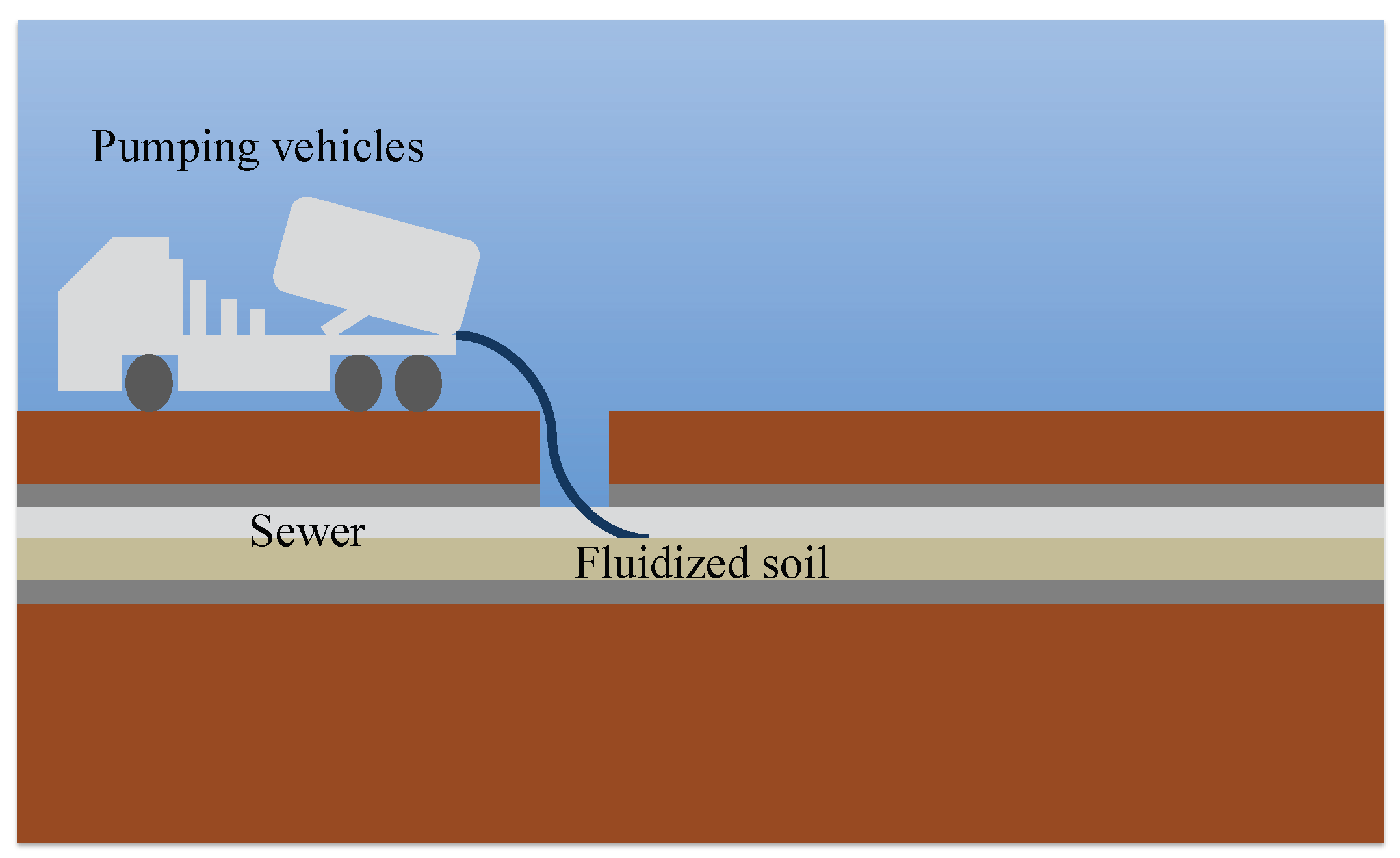
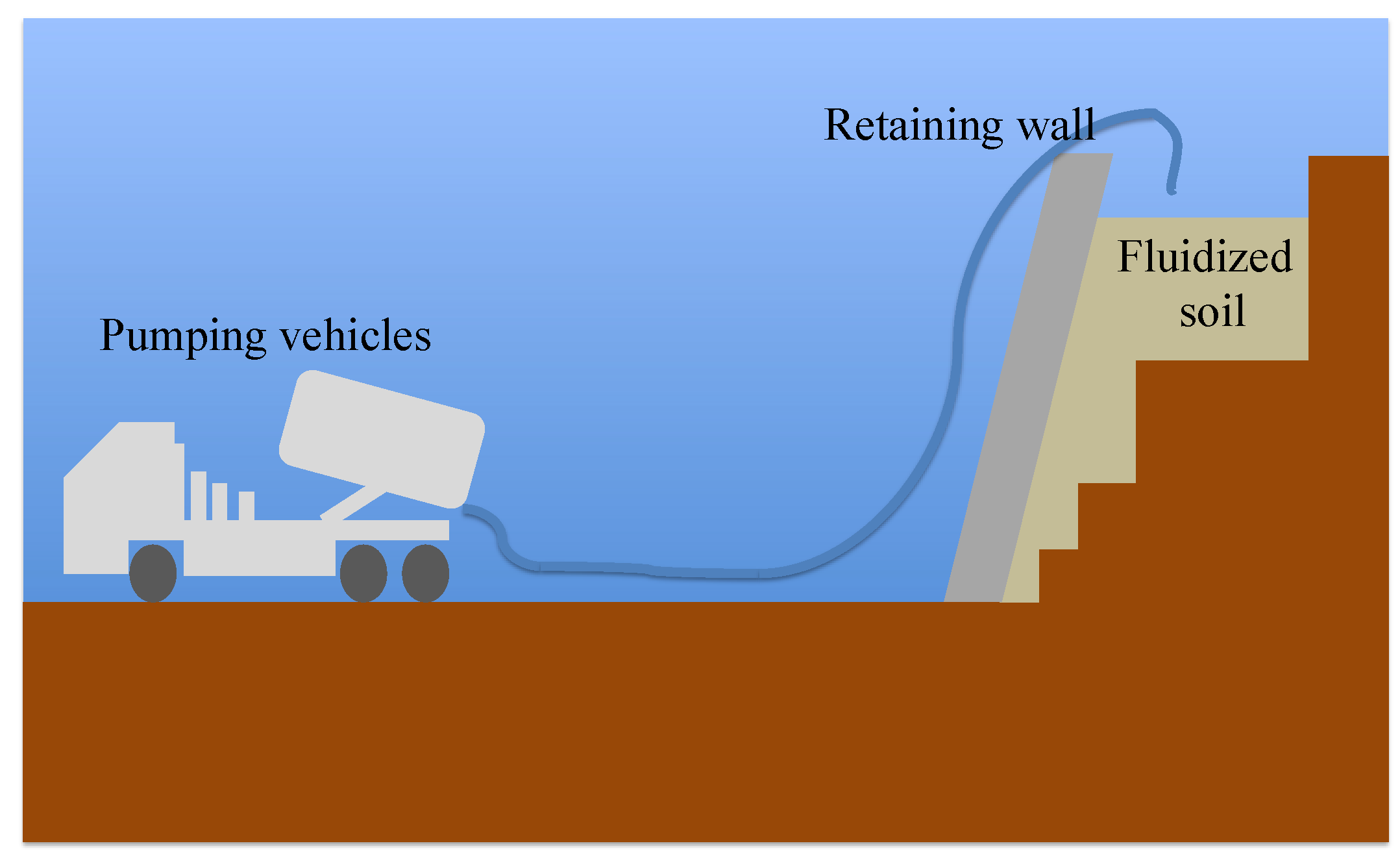
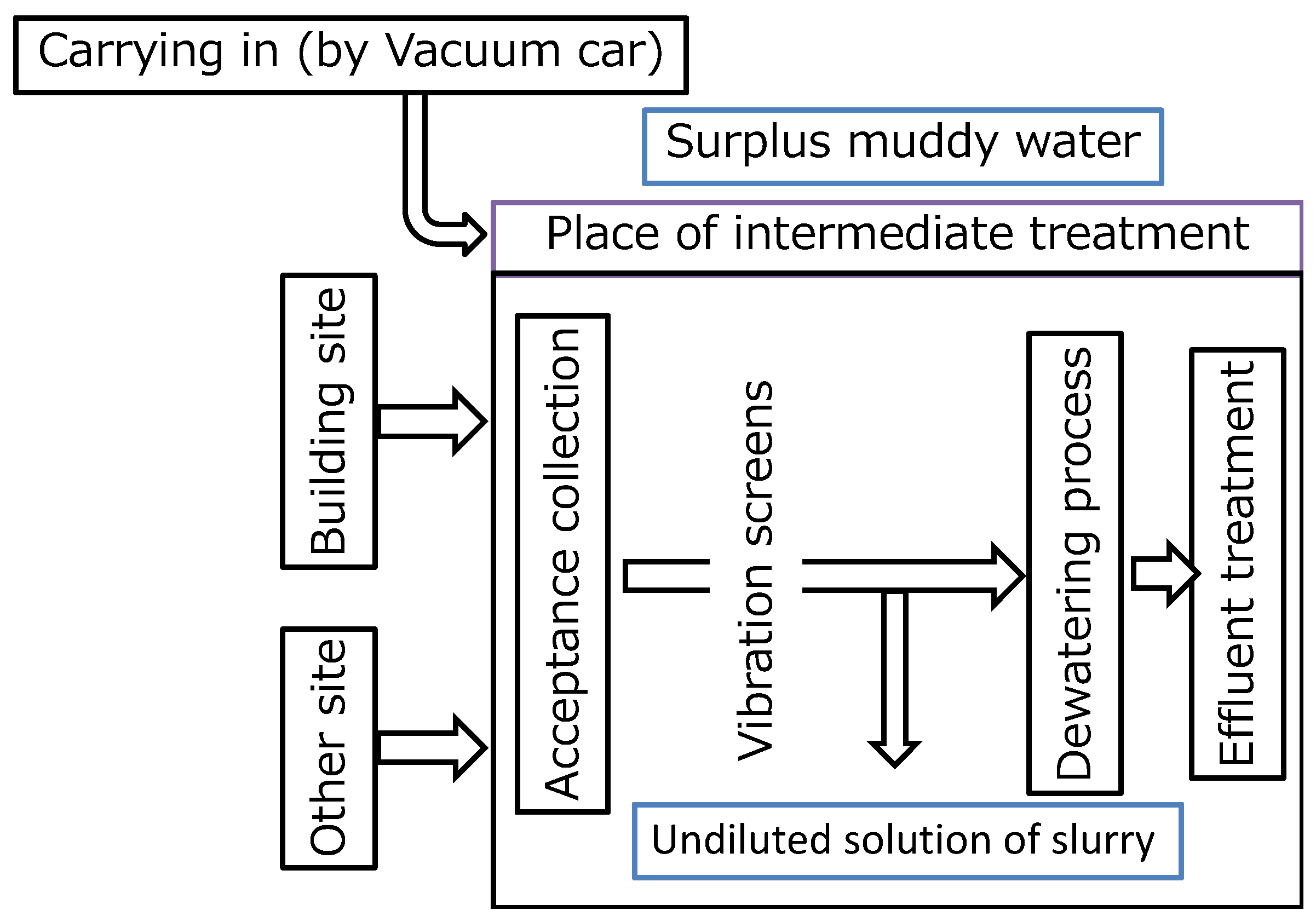


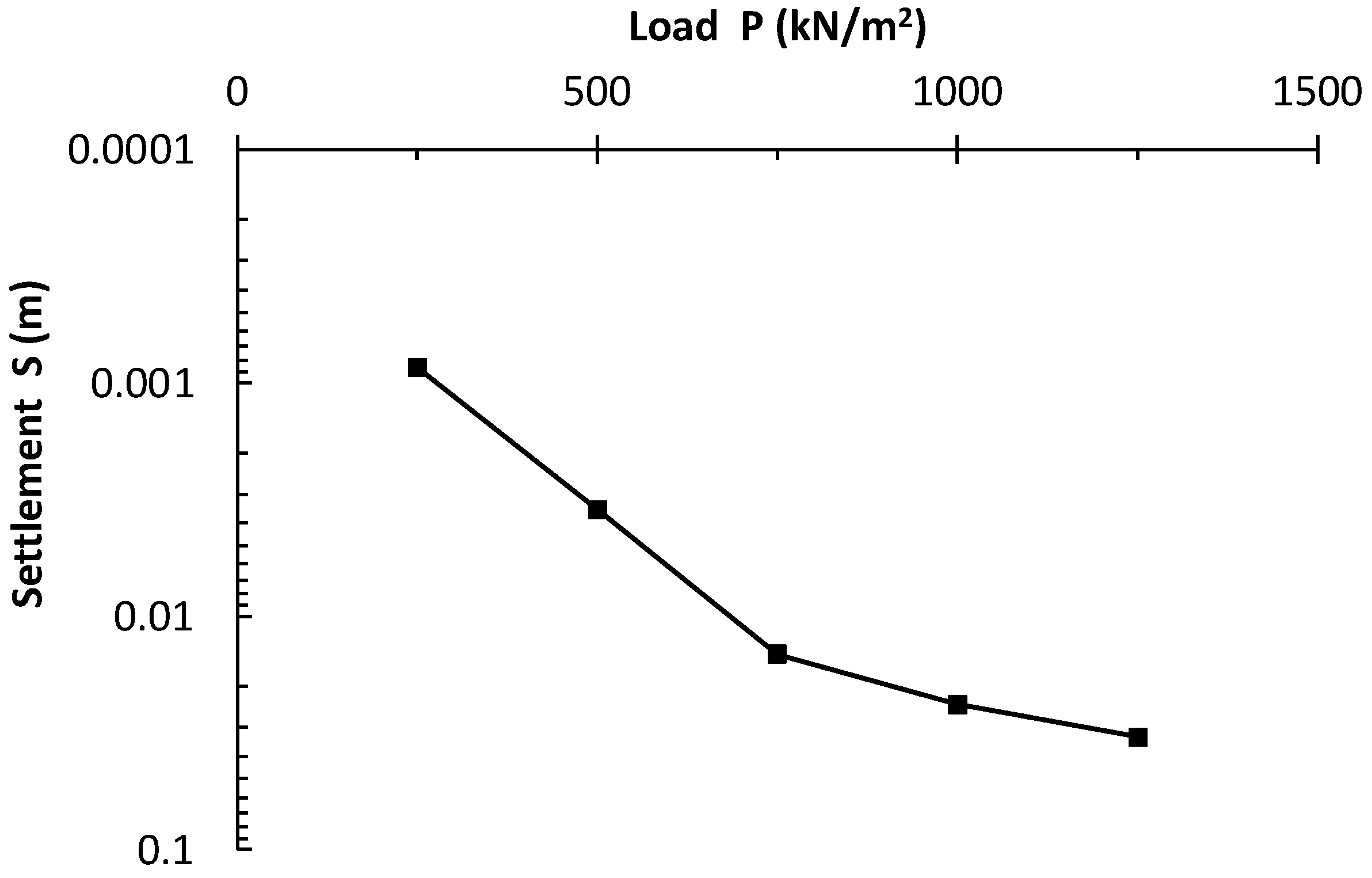

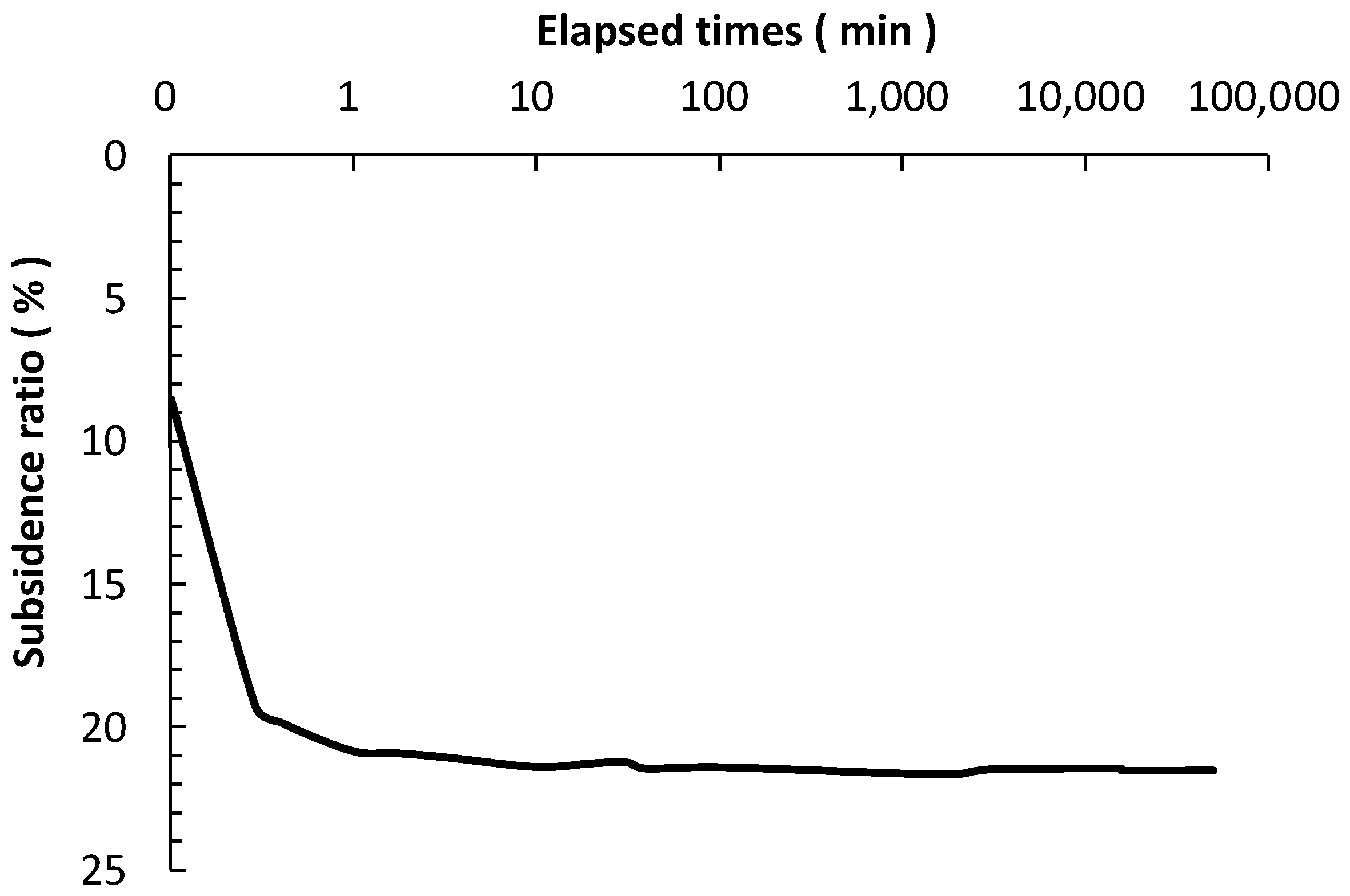
| Construction By-Product | 2008 | 2018 | Construction Recycling Promotion Plan 2014 | |
|---|---|---|---|---|
| Target Value for 2018 | Target Value Achieved | |||
| Recycling rate of asphalt and concrete lumps | 98.4% | 99.5% | 99% or more | Achieved |
| Recycling rate of concrete mass | 97.3% | 99.3% | 99% or more | Achieved |
| Rate of recycling and reduction of wood wastes from construction | 89.4% | 96.2% | 95% or more | Achieved |
| Rate of recycling and reduction of mixed construction wastes | 39.3% | 63.2% | 60% or more | Achieved |
| Effective utilization rate of construction-generated soils | 71.7% | 79.8% | 80% or more | Unachieved |
| HFLSS Made of RCS | |
|---|---|
| Wet density (kg/m3) | 1.143 |
| Undiluted solution of slurry (m3) | 1.00 |
| Cementitious solidifier (kg/m3) | 150 |
| Maximum grain size (μm) | 74 |
| LSS | HFLSS Made of RCS | |
|---|---|---|
| Stock specific gravity | 1.210 | 1.143 |
| Cementitious solidifier (kg/m3) | 150 | 150 |
| Water content (%) | 62.02 | 67.55 |
| Maximum grain size (μm) | over 74 | 74 |
| Load, Wsw (kN) | Half Rotation Speed, Na | Penetration Depth, D (m) | Penetration Amount, L (m) | Half-Turn Per 1 m, Nsw | Convention N Value | Long-Term Allowable Stress (kN/m2) |
|---|---|---|---|---|---|---|
| 0.05 | 0.05 | 0.05 | 0.2 | 0.1 | ||
| 0.15 | 0.05 | 0.00 | 0.5 | 0.7 | ||
| 0.25 | 0.06 | 0.01 | 0.8 | 1.9 | ||
| 0.50 | 0.07 | 0.01 | 1.5 | 7.5 | ||
| 0.75 | 0.08 | 0.01 | 2.3 | 16.9 | ||
| 1.00 | 0.09 | 0.01 | 3.0 | 30.0 | ||
| 1.00 | 11 | 0.25 | 0.16 | 69 | 6.5 | 71.4 |
| 1.00 | 47 | 0.50 | 0.25 | 188 | 12.4 | 142.8 |
| 1.00 | 80 | 0.75 | 0.25 | 320 | 19.0 | 222.0 |
| 1.00 | 60 | 0.80 | 0.05 | 1200 | 63.0 | 750.0 |
| LSS | HFLSS Made of RCS | |
|---|---|---|
| Flow value (m) | 0.44 | 0.54 |
| HFLSS Made of RCS | Conventional LSS | ||
|---|---|---|---|
| Material age (days) | 28 | 7 | 28 |
| Unconfined compressive strength (kN/m2) | 285–515 | over 500 | over 1000 |
| Modulus of subgrade reaction (kN/m3) | 2.2 × 104 | 2.7 × 105 | |
| CBR (lab. test) (%) | 17.7 | 40–70 | |
| CBR (site) (%) | 21.4 | over 40–70 | |
Disclaimer/Publisher’s Note: The statements, opinions and data contained in all publications are solely those of the individual author(s) and contributor(s) and not of MDPI and/or the editor(s). MDPI and/or the editor(s) disclaim responsibility for any injury to people or property resulting from any ideas, methods, instructions or products referred to in the content. |
© 2023 by the authors. Licensee MDPI, Basel, Switzerland. This article is an open access article distributed under the terms and conditions of the Creative Commons Attribution (CC BY) license (https://creativecommons.org/licenses/by/4.0/).
Share and Cite
Shigematsu, Y.; Inazumi, S.; Chaiprakaikeow, S.; Nontananandh, S. Properties of High-Flowability Liquefied Stabilized Soil Made of Recycled Construction Sludge. Recycling 2023, 8, 67. https://doi.org/10.3390/recycling8050067
Shigematsu Y, Inazumi S, Chaiprakaikeow S, Nontananandh S. Properties of High-Flowability Liquefied Stabilized Soil Made of Recycled Construction Sludge. Recycling. 2023; 8(5):67. https://doi.org/10.3390/recycling8050067
Chicago/Turabian StyleShigematsu, Yuji, Shinya Inazumi, Susit Chaiprakaikeow, and Supakij Nontananandh. 2023. "Properties of High-Flowability Liquefied Stabilized Soil Made of Recycled Construction Sludge" Recycling 8, no. 5: 67. https://doi.org/10.3390/recycling8050067
APA StyleShigematsu, Y., Inazumi, S., Chaiprakaikeow, S., & Nontananandh, S. (2023). Properties of High-Flowability Liquefied Stabilized Soil Made of Recycled Construction Sludge. Recycling, 8(5), 67. https://doi.org/10.3390/recycling8050067






